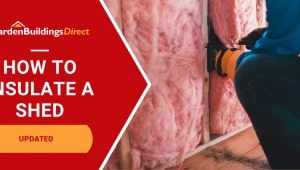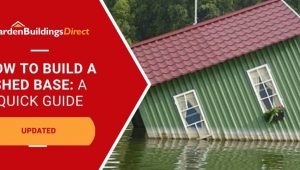Jump to:
Pressure washing can be strong, but don’t worry, it won’t damage your garden shed, as long as you know how to control it. This guide shows you the safe way to do so.
How to Pressure Wash a Shed from the Outside
The exterior is where most of the dirt and grime sit, so we’ll start here with these steps:
Rinse to set the base
Set your pressure washer to the low setting and give the walls a light rinse. Don’t blast everything off; just enough to loosen the dirt. If you spot any fragile areas, like peeling paint or rotting spots, take extra care there.
Apply your cleaner
Spray a wood-safe detergent over the walls, including the corners and edges, and leave it for a minute or two. Drips tend to happen, so check them to avoid streaks when you rinse.
Go over the walls slowly
Keep the pressure moderate and move the nozzle in steady, even passes across the walls. Take your time here, especially on the corners or trims. Adjust the angle if the water hits too hard.
*This step is the washing phase with the detergent.
Final rinse
Go over the walls with clean water, making sure all the soap comes off. Tilt the spray so water runs off the wood, and keep an eye out for any spots that didn’t get fully rinsed. Keep doing this until the surface is spotless, but don’t overdo it.
Dry before treating the shed
After rinsing, the wood will hold a bit of moisture. Give it time and airflow to settle before you apply stain or sealant. For more tips, read our guide next:
[Shed Maintenance: Treatments and Refurbishing]
Safety Warnings
- Be careful not to damage roof felt, as high pressure can lift or tear it.
- Water can force its way into panel seams and overlaps, causing swelling or leaks.
- Avoid spraying near electrics or sockets; water can create serious safety hazards.
- Check for soft or rotting timber before washing to prevent further damage.
Can I Pressure Wash Inside a Shed?
No, it’s not safe to use a pressure washer inside a shed. Water can get stuck in panel seams, floor joints, and around fixings. On plastic sheds, it can even make panels bend, and any electrics inside are at risk.
You can vacuum dust and cobwebs instead, then use a damp cloth for stubborn dirt. When doing so, keep the door and windows open to allow quick drying and prevent moisture buildup.
Tips for Using a Pressure Washer on Your Shed
- Don’t crank the pressure up too high.
- Use a fan spray to cover the surface and avoid damaging the wood.
- Go for mild, wood-safe cleaners instead of blasting dirt with force.
- Try a small hidden patch first to see how the timber reacts.
- Adjust the pressure as you go, especially on older or softer areas.
FAQs
Can you use a pressure washer on any timber shed?
Pressure washers work on most sheds, but older wood needs extra care. We recommend doing a small patch test first to see how much yours can handle.
Are these tips applicable on other garden rooms?
Most of these pressure washing tips work on a variety of garden buildings. But some details change depending on the structure and materials.
| Garden Building | Pressure Level | Areas to Watch | Cleaning Tips |
|---|---|---|---|
| Log Cabins | Medium | Log joints, corners | Wide fan spray, rinse carefully |
| Summer Houses | Medium | Window trims, roof edges | Gentle passes, avoid soaking wood |
| Greenhouses | Low | Glass panels, seals | Avoid pressure on seals, use mild spray |
| Kids’ Playhouses | Low-Medium | Plastic panels, doors, trims | Gentle spray, watch for flexing panels |
Is it necessary to seal a shed after pressure washing?
It depends on your shed’s condition, but it’s always a good idea to seal or stain it after washing. This protects the wood from moisture and keeps it looking good longer. But make sure to let it dry first!
Can you pressure wash a painted shed?
It’s fine as long as the paint is solid. Flaking or loose paint will lift, so take note of any problem areas before washing the whole wall.





